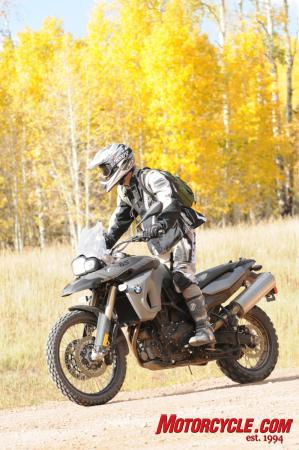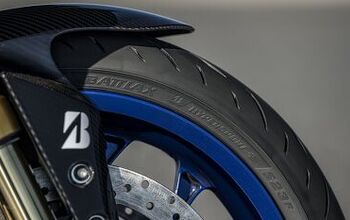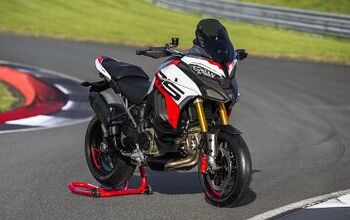2009 BMW F800GS Review - Motorcycle.com
Get the Flash Player to see this player.
Filling the gap
The venerable R1200GS is an icon of adventure riding. It set the standard from which all other bikes chasing this market segment would be judged. The growth of this on-off road market spawned a number of new-comers, some better off-road, some much lighter and more agile than the rather hefty GSs, and some just hoping to ride the GS’ coattail if only to catch the eye of would-be buyers who think themselves adventurous.
BMW saw a hole in the rapidly expanding adventure motorcycle market (a market essentially created by the company) and knew they had just the bike to fill the gap, or at least had the basic platform of a bike already in place.
On the far end of the extreme spectrum, selections are more limited with KTM’s 690 Enduro and 450 EXC trading punches with BMW’s new G450X and G650 XChallenge (though that model is dropped from the line, as is the XMoto, for 2009). In the middle ground there are even fewer players, as BMW sees it, with KTM’s 690 Adventure, and a non-U.S. model from Yamaha called the XT660Z Tenere. And this is exactly where BMW capitalized by creating the F800GS and F650GS (though still an 800cc).
German alchemy
I’ve said it before. BMW is masterful at hatching a number of different bike models from one basic engine platform. Based on the F800S and ST engine platform introduced in 2007, the company has done it again, this year crafting the two newest GS models from that same basic 798cc (82 x 75mm bore/stroke) liquid-cooled parallel Twin.
From our First Ride review we know that the GS lump saw a few structural changes, as well as a larger radiator, in order to better perform in off-road environments. Most notable was the rotation of the cylinder bank from the S and ST’s 23.3-degree forward cant to a nearly upright 8.3-degree angle. This was done primarily to allow for the 9 inches of front travel on the 800GS.
Though the street-oriented F650GS hasn’t nearly as much spring in its step, there wasn’t any need to give its cylinders any different positioning, so it shares the same basic engine as the F800GS, save for different tuning needs. Some day soon we’ll get a closer look at the F80…er, um… F650GS.
The parallel-Twin uses an even firing order (360-degree offset, or, both pistons move up and down in unison), like its bigger Boxer brothers. A benefit of such a configuration is, among other things, a torque-biased engine and a Boxer-like exhaust note. Another inherent characteristic of such an engine can be considerable vibes. Way back when I had a couple of EX500s in my garage and was an EX enthusiast, a common term of endearment I would hear often for a parallel-Twin was “sewing machine.”
Again, thinking back to my EX500 days, I was prepared for an annoying buzz but was pleasantly surprised by what is one smooth-running Twin. The middleweight mill spins quickly so I had to change my mindset, remembering that the last GS (1200) I rode was more lumbering and forgiving of eager wrist action. The 800 isn’t sportbike quick, but more mimics the responsiveness of typical dirtbike engines; top gear roll-on acceleration is sufficient for most overtaking situations.
Power is transmitted to the six-speed tranny via a wet multi-plate clutch. Having the clutch in an oil bath keeps the plates cool, a must in off-road riding where there’s often a lot of intentional clutch-slipping in low gears.
Attention to detail
Another GS-specific alteration is placement of airbox intakes. A pair of inconspicuously styled snorkels ride high, starting just above the front indicators, and blend seamlessly into the bodywork as they feed the pseudo fuel tank/airbox. If it isn’t obvious yet, the objective here is to allow you and your Mini Me GS to wade across deep creeks or streams without gulping a bunch of water into the airbox.
Something not changed from the F800S and ST is the under-the-seat location of the 4.2-gallon fuel tank. Keeping weight low is the goal, and BMW anticipates 54 mpg. In the interest of the current U.S. economy, it’s worth mentioning that the bike will run on lower octane fuel with the trade-off being some power loss.
Keeping with the adventure theme, the 800GS rolls on spoke wheels. Unlike R1200GS wheels that have the spokes anchored outward near the rims edge (cross spoke), the F’s wheel spokes anchor in the center like your average dirt wheel to allow for use of tubed tires. The bike will come standard with pavement-friendly Bridgestone Battle Wings, but our test units had Continental’s Twinduro spooned on.
The more aggressive knobbies faired well-enough on the street but did so-so off-road in the opinion of a number of the dedicated dirt bikers on hand. I don’t have quite the off-road acumen to be able to notice a slight lack of grip in the dirt as a handful of motoheads did, but I did notice that the compound was a tad hard and at times easy to spin up under hard acceleration on the pavement. Also, disabling ABS and locking-up the back wheel had the rear tire feeling super-slick, as if it were on ice. On a related note, the front tire’s subfender rides awfully close to the tire but at no time during my ride did mud, twigs, rocks, etc, wedge between the lower fender and front tire.
Whatever tire you ride, keeping them in contact with Earth is the work of an USD non-adjustable 45mm Marzocchi fork with 9 inches of travel; a Sachs shock with 8.5 inches of travel and adjustable rebound damping connects directly to the aluminium double-sided swingarm. The shock also offers remote preload adjustment via a dial behind the rider’s right leg. Spring rates might have been slightly firm for my 150-plus pounds, but in reality I didn’t happen to think on such issues until after the ride. Suspension operated optimally on-road.
Some additional notes include: Decent wind protection from the diminutive windscreen, the tapered aluminium handlebars can be positioned more forward for you aggressive off-roaders who like to stand on the pegs, a nylon (read: plastic) belly pan protector that isn’t big enough to protect crucial items like the oil filter is included, brake and clutch levers are adjustable, and a power plug for jacking in your heated vest and whatnot is located near the ignition – making stringing a long wire a thing of the past.
Also, the ignition key, like many modern autos, is coded to the ignition switch, so they must pair-up to start the bike. Another thoughtful feature is the photosensitive instrument panel. Pass through a tunnel in the middle of the day and panel lights will brighten.
“Value Meal number 1, please!”
As we all know (or at least the Forum crowd seems to believe as much), few people purchase an un-optioned Beemer. BMW’s own research has proved this to be the case. According to Pieter de Waal, BMW Motorrad USA V.P., 95% of U.S. customers order ABS on BMW bikes that have the option.
In an effort to expedite things on the showroom floor and eliminate what can be a confusing menu of available options, most F800GS models will come with the “Standard Package.” Though the name seems a bit of an oxymoron, this option level contains what BMW determined to be the most commonly ordered extras: heated grips, on-board computer, ABS and white turnsignals. This, along with the very handy centerstand ($150), was the same arrangement our test units had. In the real world, where I would have to pay for the motorcycles I ride, this package raises the base price of $10,520 to $12,025. Neither price includes that annoying destination charge of $495.
I did a little poking and prodding, trying to extract secrets from de Waal, to see if an Adventure model is in the works. Seeming a little surprised by the question, as if maybe it was something to think about, he said that he knew of no such plans from Germany.
Say what you will about BMW’s elusive base models, anyway you slice it the littlest GS offers tremendous value and should cause some feverish head scratching from other makes. With its relative light weight and its ability to traverse some gnarly terrain, this new BMW poses a serious threat to the likes of Triumph’s Tiger ($11,999 w/ABS) and Suzuki’s VStrom DL 1000 ($9,199). Even KTM’s 990 Adventure ($14,398) should be looking over its shoulder.
More so, I wouldn’t be surprised if this new middleweight adventure machine cuts into the sales success of the very bike that inspired its creation.
The Perfect Bike For...Those who’ve dreamed of adventure riding but have been put-off by the size heft and price range of the likes of BMW’s R1200GS or KTM’s 990 Adventure, but didn’t see any other options… until now.- More sane seat height
- Very capable off- and on-road
- A little GS of your very own
- Needs bigger belly pan bash guard
- Optional low seat's edge a little hard/"sharp"
- No Adventure model planned
More by Pete Brissette



































Comments
Join the conversation